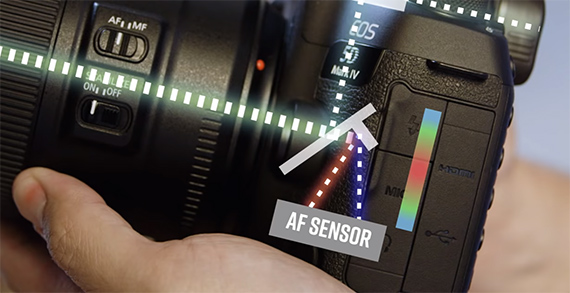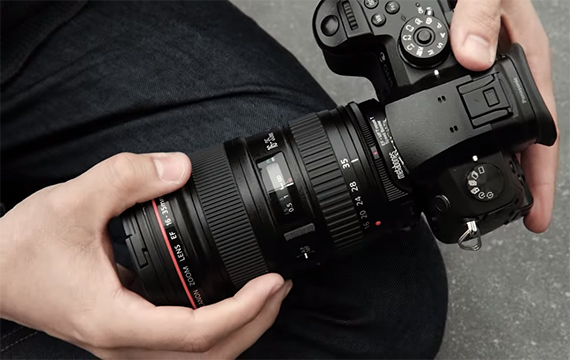The good thing about technologies is that they keep on changing for the better. Just a few decades ago, photographers debated whether going digital would really be necessary. Today, mirrorless camera manufacturers are claiming that mirrorless is the future of DSLRs. But do mirrorless cameras really offer such substantial benefits, and do they really have what it takes to be your next camera? Photographer David Flores from B&H explains.
Mirrorless cameras have a compact form factor
One of the major reasons for DSLRs to have a hefty size is the inclusion of a mirror box and a penta-prism. These mechanisms allow a photographer to see exactly what the lens is seeing but in turn increase the size and weight of the camera. Mirrorless cameras on the other hand are able to reduce their size by eliminating both of these and show the photographer what the camera is actually seeing. If weight is your concern, mirrorless cameras are the winner here.
Viewfinder
DSLRs with their optical viewfinders allow a photographer to see what the lens is actually seeing without even turning the camera on. The viewfinders do not suffer from any kind of lag and refresh rate is not an issue. Meanwhile, with their electronic viewfinders or a rear LCD screen, mirrorless cameras allow a photographer to see what the sensor is seeing. Any changes in camera settings (aperture, shutter speed, ISO, camera effects for example) are immediately reflected in the viewfinder and the photographer can exactly see what the final photograph will look like. With electronic viewfinders, “what you see is what you get”. But, as mirrorless cameras have an electronic viewfinder, you will not be able to see through the viewfinder unless the camera is turned on.
Autofocus system
DSLRs have always been a reliable work-horse with their brilliant, time-tested and proven auto focus system. They have a dedicated phase detect auto-focus (PDAF) sensor which quickly locks on to the subject even in challenging lighting conditions. Mirrorless cameras have an on-sensor mix of contrast detect and phase detect auto-focus systems (hybrid auto focus system) which the professionals are still not ready to rely on because of inconsistent results. Mirrorless cameras are playing a catch-up game as far as auto focus is concerned but with the release of the Sony A9, Sony may have finally caught up. Let’s wait and see.

Dedicated AF sensor on a DSLR helps in achieving precise focus very quickly
Battery life
The bigger body size of DSLRs allow them to house a bigger battery. Combine that with the optical viewfinder which does not use any power and you have a perfect system for long battery life – hence more shots. Mirrorless cameras are at a disadvantage here because they tend to house a smaller battery to keep the form factor of the camera small, and the viewfinder and the LCD screen both suck good amount of battery juice. Recent cameras from Sony like the A9 and A7III have tried to eliminate this problem by upping the camera size a little bit to accommodate a larger battery.
Lens choice
DSLRs are a mature system and they have a good line-up of native as well as third party lenses for almost any kind of requirement. Mirrorless cameras are relatively very new and manufacturers have been steadily adding lenses to the arsenal. However, with their short flange distance, mirrorless cameras allow photographers to “adapt lenses”. For example, if you own a Sony mirrorless body, you could use an adapter to adapt a Canon glass to your system. However, the performance will surely be far from that of a native lens. Also, depending on the adapter being used, the lens may or may not auto focus, allow aperture control via camera, and transmit EXIF data.

Panasonic mirrorless camera with a Canon lens using metabones adapter
At the end of the day it is about how the equipment in your hand will assist you to get the shot you desire. Do you seek convenience and are ready to adopt newer technology or do you want a no-nonsense, reliable work horse? The choice is all yours to make.
Go to full article: Differences Between Mirrorless and DSLR Cameras
Did you appreciate this newsletter? Please help us keep it going by Joining Our Patreon Supporters
What are your thoughts on this article? Join the discussion on our Facebook Page
PictureCorrect subscribers can also learn more today with our #1 bestseller: The Photography Tutorial eBook
The post Differences Between Mirrorless and DSLR Cameras appeared first on PictureCorrect.
from PictureCorrect https://ift.tt/vpg4asc
via IFTTT






0 kommenttia:
Lähetä kommentti